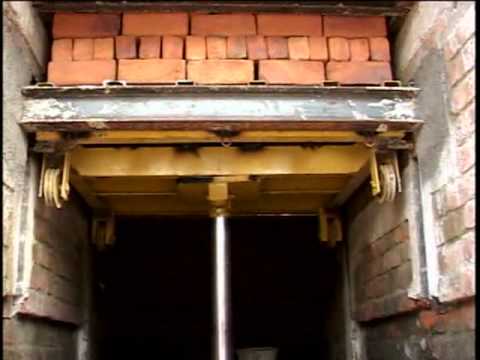Vertical Shaft Brick Kiln: Difference between revisions
Jump to navigation
Jump to search
m (categorized) |
|||
| Line 69: | Line 69: | ||
[[Category:Housing and construction]] | [[Category:Housing and construction]] | ||
[[Category:Materials]] | |||
Revision as of 15:15, 16 April 2016
About
- updraft kiln for firing bricks
- updraft = heat is reused (cold air entering below cools down the bricks, is then used for firing, then pre-warms up the still-cold bricks on top)
- developed in China in the late 1960s during the cultural revolution
- combines low cost of updraft firing with high fuel economy
- usually fired with low-grade coal fines
- said to be twice to three times as energy efficient as Hoffmann kiln
- average energy consumption figures (China): 0.103 kg coal per brick or 975 MJ/kg per 1000 bricks
- firing shaft is very well insulated on all four sides, minimizing heat loss
- bricks are loaded at the top and removed at ground level in a continuous process (see animation below for details)
- each batch of bricks is made up of four layers, making a total of 320 bricks per batch
- many kilns put out 10,000-15,000 bricks per day.
- operation is very similar to that of a vertical shaft lime kiln
- The firing process is completed within a 24-hour period (one batch takes about 24-30h to move from top to bottom)
Videos
Related Pages On This Wiki
Pros and Cons vs. Compressed Earth Blocks
Pro:
- no liquid fuel needed (e.g. diesel, ethanol) that would otherwise be required for the CEB press; energy savings due to lower-grade fuel and no need for liquid fuel distillation
- uses low-cost / low-quality fuel such as coal fines or charcoal fines, possibly pyrolysis gas from other processes
- carbon negativity more easily achieved (if part of a Biochar/Brick Co-production System)
- possibility to re-used waste heat (space heating for applications such as greenhouses, fish tanks, etc.)
- no stabilizer needed (e.g. lime, flyash, etc.), leading to energy savings
- reduced wear and tear on the infrastructure per brick (volume is large)
- possibly more stable and more weather-resistant bricks (this requires comparisons, lab testing)
- CEBs may not be suitable for all applications anyway (e.g. where they are exposed to a lot of water), so an alternative is needed. Fired bricks are a good, proven alternative.
- bricks are of consistently high quality (in fact, they HAVE to be, because of the compressive force that they have to withstand for the stacking)
- likely less work needed per brick for handling (one of the links below describes the labor requirements thusly: "Labour requirements are low, requiring one man to load and two men to unload, during an 8 or 12 hour shift. The labourers are not working continuously, as there are 3 or 4 hours between each loading/unloading session.")
- less need to monitor bricks over weeks (e.g. curing of CEBs with moisture monitoring etc.)
Con:
- possibly increased fuel use per brick. This is not certain, as the VSBK is very energy efficient, and the fuel use for CEBs is not zero either. Calculations are difficult because of very different fuel types.
- a larger installation means less flexibility (this facility is not easy to move, in contrast to CEB press, although moving the kiln has actually been done in China)
- potential air pollution problems (this is largely a factor of higher volume/concentration of production)
- requirement for continuous operation on nights/weekends (there are breaks though - see labor requirements under "Pro")
- VSBK is only for the production of bricks. Tiles would have to be fired in some other way.
- need for a well-trained, skilled "brickmaster" who is able to keep the fire at the right level and intensity
- possibly more stringent requirements for suitability of clay
Development Proposal
The standard VSBK is coal-fired (low-quality coal fines). As shown in the animation above (on Vimeo), pieces of coal are scattered onto the bricks from the top. If such a brick kiln were re-designed as part of a pyrolysis system and using just the gas Biochar/Brick Co-production System), what would it look like? How can firing of the central bricks be assured if gas enters from the sides?
Further Information (links)
- http://www.swisscontact.org/fileadmin/media/Medienberichte/0913_Vertical_Shaft_Brick_Kiln_VSBK_01.pdf (internal copy: here)
- http://www.fastonline.org/CD3WD_40/GATE_DL/BUILDING/VS/EN/VS.HTM
- http://www.teriin.org/technology/brick-kiln-technology
- Devalt.org: "The Vertical Shaft Brick Kiln : a technology for the masses" (internal copy here)
- Article from GATE - 4/91 - Environmental NGOs Humanity Development Library - The Chinese vertical Brick Kiln
